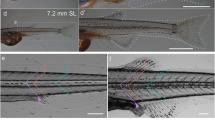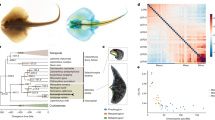Abstract
The origin of paired appendages was a major evolutionary innovation for vertebrates, marking the first step towards fin- (and later limb-) driven locomotion. The earliest vertebrate fossils lack paired fins but have well-developed median fins1,2, suggesting that the mechanisms of fin development were assembled first in the midline. Here we show that shark median fin development involves the same genetic programs that operate in paired appendages. Using molecular markers for different cell types, we show that median fins arise predominantly from somitic (paraxial) mesoderm, whereas paired appendages develop from lateral plate mesoderm. Expression of Hoxd and Tbx18 genes, which specify paired limb positions3,4, also delineates the positions of median fins. Proximodistal development of median fins occurs beneath an apical ectodermal ridge, the structure that controls outgrowth of paired appendages5,6,7. Each median fin bud then acquires an anteroposteriorly-nested pattern of Hoxd expression similar to that which establishes skeletal polarity in limbs8,9. Thus, despite their different embryonic origins, paired and median fins utilize a common suite of developmental mechanisms. We extended our analysis to lampreys, which diverged from the lineage leading to gnathostomes before the origin of paired appendages2,10, and show that their median fins also develop from somites and express orthologous Hox and Tbx genes. Together these results suggest that the molecular mechanisms for fin development originated in somitic mesoderm of early vertebrates, and that the origin of paired appendages was associated with re-deployment of these mechanisms to lateral plate mesoderm.
This is a preview of subscription content, access via your institution
Access options
Subscribe to this journal
Receive 51 print issues and online access
$199.00 per year
only $3.90 per issue
Buy this article
- Purchase on Springer Link
- Instant access to full article PDF
Prices may be subject to local taxes which are calculated during checkout




Similar content being viewed by others
References
Zhang, X. G. & Hou, X. G. Evidence for a single median fin-fold and tail in the Lower Cambrian vertebrate, Haikouichthys ercaicunensis. J. Evol. Biol. 17, 1162–1166 (2004)
Coates, M. I. The origin of vertebrate limbs. Development (Suppl.), 169–182 (1994)
Cohn, M. J. et al. Hox9 genes and vertebrate limb specification. Nature 387, 97–101 (1997)
Tanaka, M. & Tickle, C. Tbx18 and boundary formation in chick somite and wing development. Dev. Biol. 268, 470–480 (2004)
Saunders, J. W. The proximo-distal sequence of origin of parts of the chick wing and the role of the ectoderm. J. Exp. Zool. 108, 363–403 (1948)
Grandel, H. & Schulte-Merker, S. The development of the paired fins in the zebrafish (Danio rerio). Mech. Dev. 79, 99–120 (1998)
Grandel, H., Draper, B. W. & Schulte-Merker, S. dackel acts in the ectoderm of the zebrafish pectoral fin bud to maintain AER signaling. Development 127, 4169–4178 (2000)
Zakany, J., Kmita, M. & Duboule, D. A dual role for Hox genes in limb anterior-posterior asymmetry. Science 304, 1669–1672 (2004)
Tarchini, B. & Duboule, D. Control of Hoxd genes collinearity during early limb development. Dev. Cell 10, 93–103 (2006)
Donoghue, P. C. J., Forey, P. L. & Aldridge, R. J. Conodont affinity and chordate phylogeny. Biol. Rev. Camb. Philos. Soc. 75, 191–251 (2000)
Sun, X., Mariani, F. V. & Martin, G. R. Functions of FGF signalling from the apical ectodermal ridge in limb development. Nature 418, 501–508 (2002)
Tucker, A. S. & Slack, J. M. Independent induction and formation of the dorsal and ventral fins in Xenopus laevis. Dev. Dyn. 230, 461–467 (2004)
Smith, M., Hickman, A., Amanze, D., Lumsden, A. & Thorogood, P. Trunk neural crest origin of caudal fin mesenchyme in the zebrafish Brachydanio rerio. Proc. R. Soc. Lond. B 256, 137–145 (1994)
Sobkow, L., Epperlein, H. H., Herklotz, S., Straube, W. L. & Tanaka, E. M. A germline GFP transgenic axolotl and its use to track cell fate: dual origin of the fin mesenchyme during development and the fate of blood cells during regeneration. Dev. Biol. 290, 386–397 (2006)
Furumoto, T. A. et al. Notochord-dependent expression of MFH1 and PAX1 cooperates to maintain the proliferation of sclerotome cells during the vertebral column development. Dev. Biol. 210, 15–29 (1999)
Sun Rhodes, L. S. & Merzdorf, C. S. The zic1 gene is expressed in chick somites but not in migratory neural crest. Gene Expr. Patterns 6, 539–545 (2006)
Brent, A. E., Schweitzer, R. & Tabin, C. J. A somitic compartment of tendon progenitors. Cell 113, 235–248 (2003)
Brent, A. E. & Tabin, C. J. FGF acts directly on the somitic tendon progenitors through the Ets transcription factors Pea3 and Erm to regulate scleraxis expression. Development 131, 3885–3896 (2004)
Lacosta, A. M., Muniesa, P., Ruberte, J., Sarasa, M. & Dominguez, L. Novel expression patterns of Pax3/Pax7 in early trunk neural crest and its melanocyte and non-melanocyte lineages in amniote embryos. Pigment Cell Res. 18, 243–251 (2005)
Trevarrow, B., Marks, D. L. & Kimmel, C. B. Organization of hindbrain segments in the zebrafish embryo. Neuron 4, 669–679 (1990)
Mabee, P. M., Crotwell, P. L., Bird, N. C. & Burke, A. C. Evolution of median fin modules in the axial skeleton of fishes. J. Exp. Zool. 294, 77–90 (2002)
Sordino, P., Van der Hoeven, F. & Duboule, D. Hox gene expression in teleost fins and the origin of vertebrate digits. Nature 375, 678–681 (1995)
Nelson, C. E. et al. Analysis of Hox gene expression in the chick limb bud. Development 122, 1449–1466 (1996)
Richardson, M. K. & Wright, G. M. Developmental transformations in a normal series of embryos of the sea lamprey Petromyzon marinus (Linnaeus). J. Morphol. 257, 348–363 (2003)
Hirata, M., Ito, K. & Tsuneki, K. Migration and colonization patterns of HNK-1-immunoreactive neural crest cells in lamprey and swordtail embryos. Zool. Sci 14, 305–312 (1997)
McCauley, D. W. & Bronner-Fraser, M. Neural crest contributions to the lamprey head. Development 130, 2317–2327 (2003)
Force, A., Amores, A. & Postlethwait, J. H. Hox cluster organization in the jawless vertebrate Petromyzon marinus. J. Exp. Zool. 294, 30–46 (2002)
Akimenko, M. A., Ekker, M., Wegner, J., Lin, W. & Westerfield, M. Combinatorial expression of three zebrafish genes related to distal-less: part of a homeobox gene code for the head. J. Neurosci. 14, 3475–3486 (1994)
Akimenko, M. A., Johnson, S. L., Westerfield, M. & Ekker, M. Differential induction of four msx homeobox genes during fin development and regeneration in zebrafish. Development 121, 347–357 (1995)
Freitas, R. & Cohn, M. J. Analysis of EphA4 in the lesser spotted catshark identifies a primitive gnathostome expression pattern and reveals co-option during evolution of shark-specific morphology. Dev. Genes Evol. 214, 466–472 (2004)
Acknowledgements
We thank A. Burke, P. Mabee, P. Crotwell and B. Shockey for commenting on the manuscript, A. Graham for sharing reagents, and L. Page and G. Weddle for assistance with lamprey collection. R. Freitas is a PhD student of the GABBA Program (ICBAS, Univ. Oporto) and was supported by a fellowship from FCT, Praxis XXI. Author contributions R.F. performed and designed (with M.J.C.) the reported studies. G.Z. performed part of the gene cloning and phylogenetic analyses. M.J.C. supervised the research project, and assisted in the experimental design. R.F. and M.J.C. wrote the manuscript. All authors discussed the results and commented on the manuscript.
Author information
Authors and Affiliations
Corresponding author
Ethics declarations
Competing interests
Reprints and permissions information is available at npg.nature.com/reprintsandpermissions. Sequences for Foxc2, Zic1, Scleraxis, Pax7, Hoxd9, Hoxd10, Hoxd12, Hoxd13 and Tbx18 from S. canicula, and Parascleraxis and Tbx15/18 from P. marinus, are deposited in GenBank under accession numbers DQ659101–DQ659111. The authors declare no competing financial interests.
Additional information
Sequences for Foxc2, Zic1, Scleraxis, Pax7, Hoxd9, Hoxd10, Hoxd12, Hoxd13 and Tbx18 from S. canicula, and Parascleraxis and Tbx15/18 from P. marinus, are deposited in GenBank under accession numbers DQ659101–DQ659111.
Supplementary information
Supplementary Notes
This file contains Supplementary Figures 1–8, Supplementary Methods, and seven references. (PDF 13253 kb)
Rights and permissions
About this article
Cite this article
Freitas, R., Zhang, G. & Cohn, M. Evidence that mechanisms of fin development evolved in the midline of early vertebrates. Nature 442, 1033–1037 (2006). https://doi.org/10.1038/nature04984
Received:
Accepted:
Published:
Issue Date:
DOI: https://doi.org/10.1038/nature04984
This article is cited by
-
A median fin derived from the lateral plate mesoderm and the origin of paired fins
Nature (2023)
-
Galeaspid anatomy and the origin of vertebrate paired appendages
Nature (2022)
-
Developmental independence of median fins from the larval fin fold revises their evolutionary origin
Scientific Reports (2022)
-
Adipose fin development and its relation to the evolutionary origins of median fins
Scientific Reports (2019)
-
Molecular ontogeny of the stomach in the catshark Scyliorhinus canicula
Scientific Reports (2019)
Comments
By submitting a comment you agree to abide by our Terms and Community Guidelines. If you find something abusive or that does not comply with our terms or guidelines please flag it as inappropriate.



